HR Training and Development Plan for Mad Munch Restaurant Chain
VerifiedAdded on 2023/03/23
|9
|2309
|91
Report
AI Summary
This report presents a comprehensive training plan for Mad Munch, an Australian-based restaurant chain, focusing on key areas of Human Resource Development. The plan outlines training objectives, methods, and materials for both managers and employees, addressing critical issues such as attracting and engaging the workforce, eliminating sexual harassment, promoting responsible internet usage, managing workplace stress, fostering an inclusive environment for staff with disabilities, and prioritizing safety. The training methods emphasize verbal communication and visual presentation, utilizing tools like Prezi to enhance engagement. The lesson plan includes handbooks, note-taking, and various training materials such as hands-on activities, group building exercises, and audio-visual presentations. The program evaluation plan incorporates cognitive learning theory, focusing on self-confidence, monitoring learning, and self-authoritarian techniques. Specific training programs for managers and employees are detailed, including strategies for workforce engagement, anti-harassment training, responsible internet use guidelines, stress management techniques, disability sensitivity training, and safety protocols. The overall goal is to create a safer, more inclusive, and productive workplace within Mad Munch restaurants.
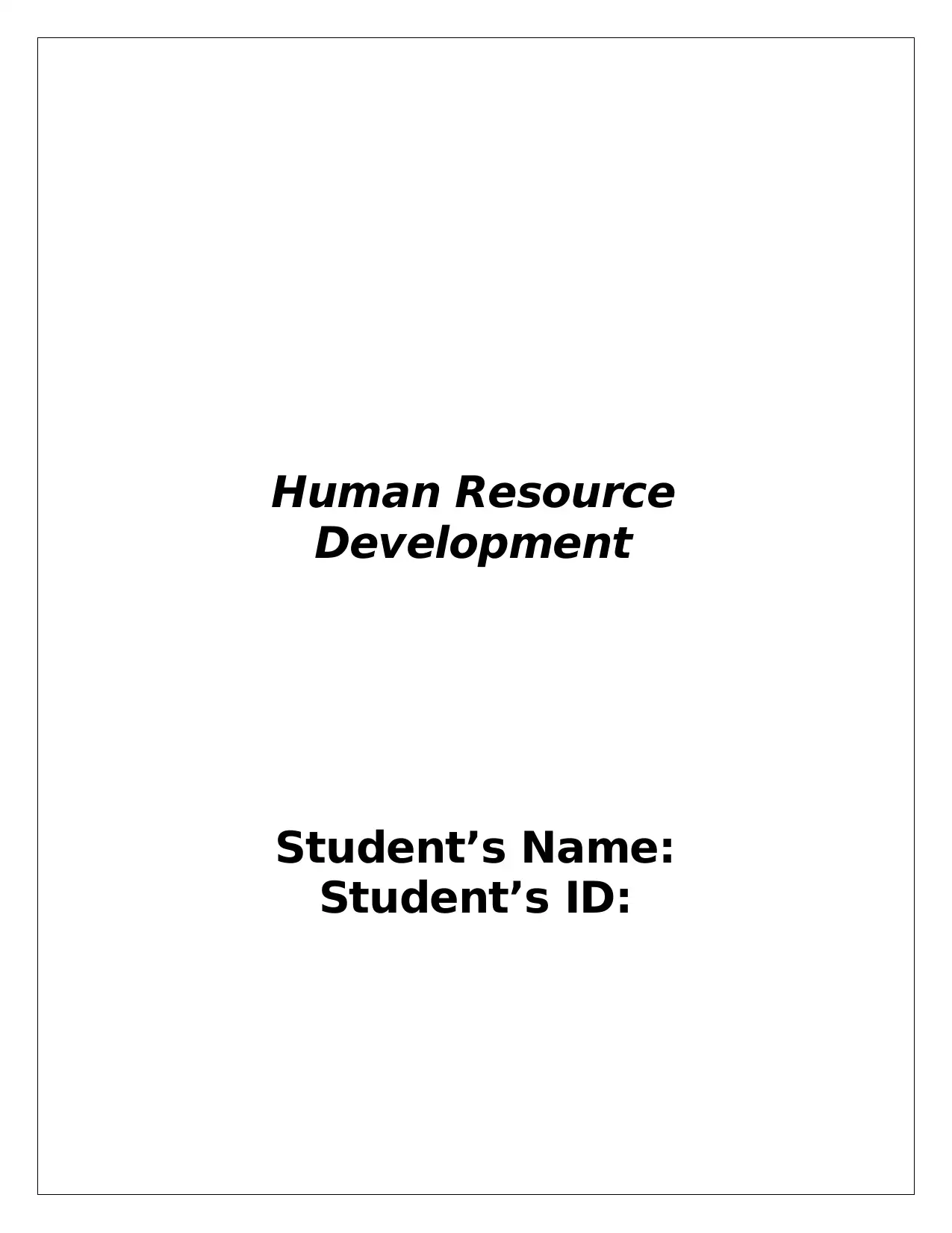
Human Resource
Development
Student’s Name:
Student’s ID:
Development
Student’s Name:
Student’s ID:
Paraphrase This Document
Need a fresh take? Get an instant paraphrase of this document with our AI Paraphraser
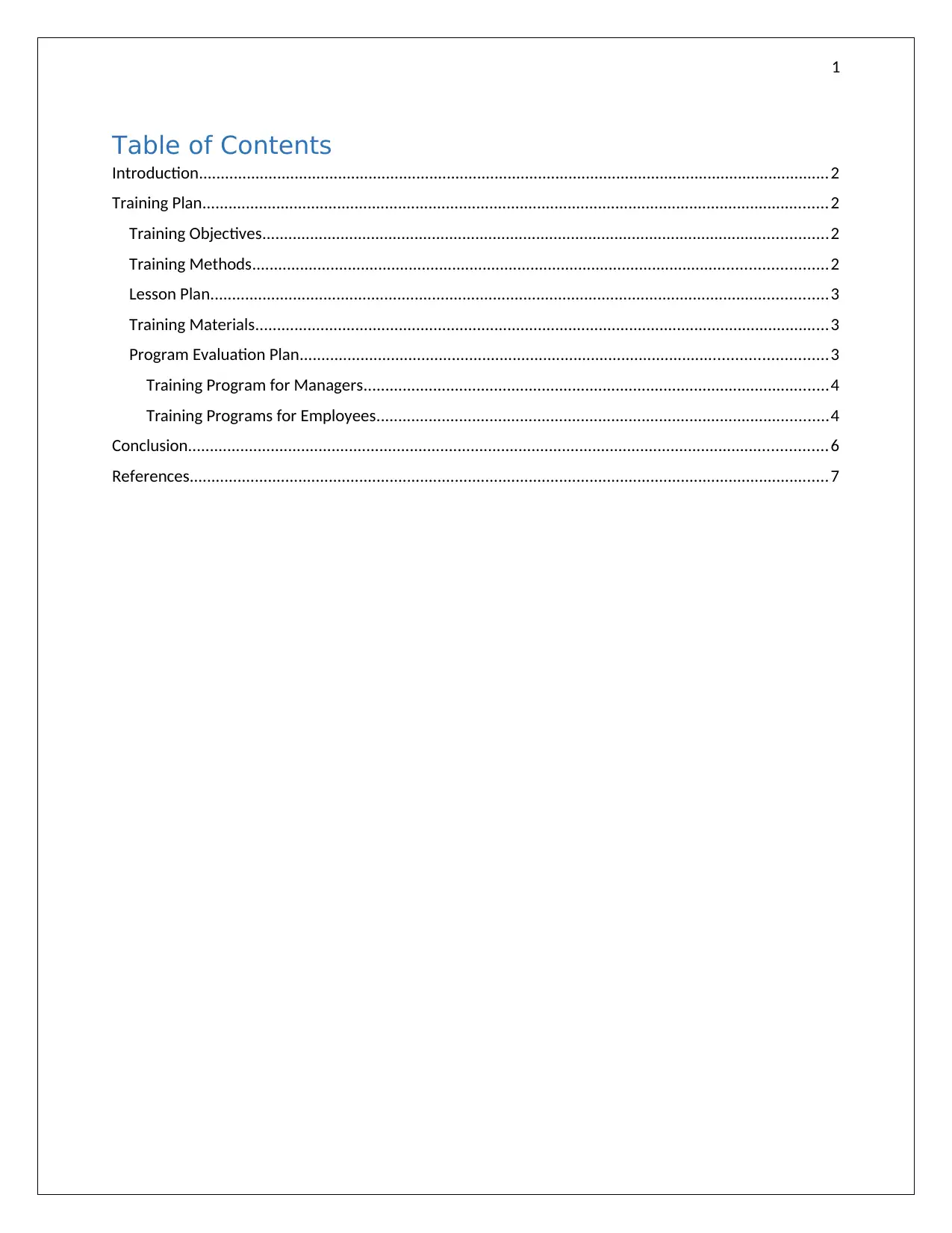
1
Table of Contents
Introduction.................................................................................................................................................2
Training Plan................................................................................................................................................2
Training Objectives..................................................................................................................................2
Training Methods....................................................................................................................................2
Lesson Plan..............................................................................................................................................3
Training Materials....................................................................................................................................3
Program Evaluation Plan.........................................................................................................................3
Training Program for Managers...........................................................................................................4
Training Programs for Employees........................................................................................................4
Conclusion...................................................................................................................................................6
References...................................................................................................................................................7
Table of Contents
Introduction.................................................................................................................................................2
Training Plan................................................................................................................................................2
Training Objectives..................................................................................................................................2
Training Methods....................................................................................................................................2
Lesson Plan..............................................................................................................................................3
Training Materials....................................................................................................................................3
Program Evaluation Plan.........................................................................................................................3
Training Program for Managers...........................................................................................................4
Training Programs for Employees........................................................................................................4
Conclusion...................................................................................................................................................6
References...................................................................................................................................................7
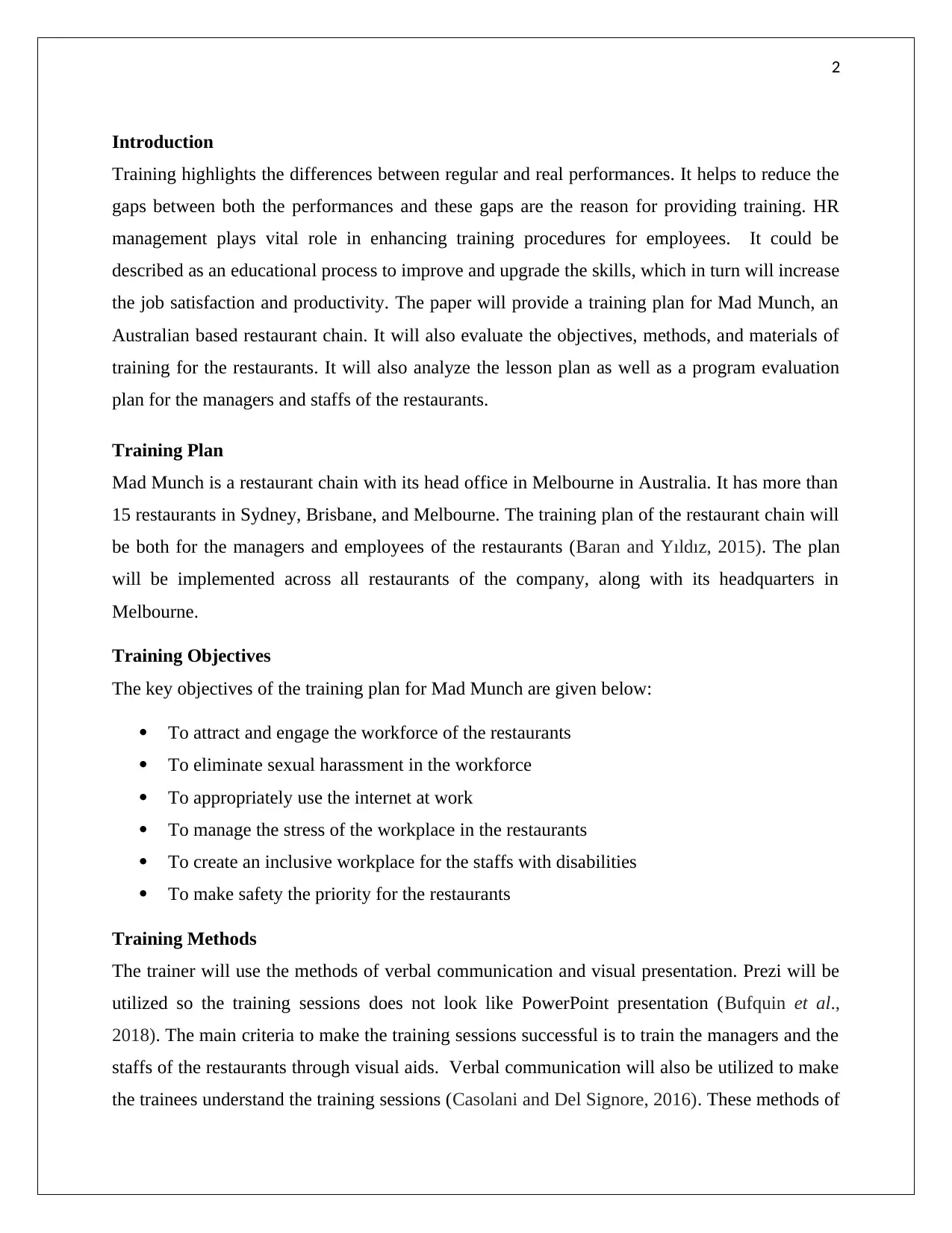
2
Introduction
Training highlights the differences between regular and real performances. It helps to reduce the
gaps between both the performances and these gaps are the reason for providing training. HR
management plays vital role in enhancing training procedures for employees. It could be
described as an educational process to improve and upgrade the skills, which in turn will increase
the job satisfaction and productivity. The paper will provide a training plan for Mad Munch, an
Australian based restaurant chain. It will also evaluate the objectives, methods, and materials of
training for the restaurants. It will also analyze the lesson plan as well as a program evaluation
plan for the managers and staffs of the restaurants.
Training Plan
Mad Munch is a restaurant chain with its head office in Melbourne in Australia. It has more than
15 restaurants in Sydney, Brisbane, and Melbourne. The training plan of the restaurant chain will
be both for the managers and employees of the restaurants (Baran and Yıldız, 2015). The plan
will be implemented across all restaurants of the company, along with its headquarters in
Melbourne.
Training Objectives
The key objectives of the training plan for Mad Munch are given below:
To attract and engage the workforce of the restaurants
To eliminate sexual harassment in the workforce
To appropriately use the internet at work
To manage the stress of the workplace in the restaurants
To create an inclusive workplace for the staffs with disabilities
To make safety the priority for the restaurants
Training Methods
The trainer will use the methods of verbal communication and visual presentation. Prezi will be
utilized so the training sessions does not look like PowerPoint presentation (Bufquin et al.,
2018). The main criteria to make the training sessions successful is to train the managers and the
staffs of the restaurants through visual aids. Verbal communication will also be utilized to make
the trainees understand the training sessions (Casolani and Del Signore, 2016). These methods of
Introduction
Training highlights the differences between regular and real performances. It helps to reduce the
gaps between both the performances and these gaps are the reason for providing training. HR
management plays vital role in enhancing training procedures for employees. It could be
described as an educational process to improve and upgrade the skills, which in turn will increase
the job satisfaction and productivity. The paper will provide a training plan for Mad Munch, an
Australian based restaurant chain. It will also evaluate the objectives, methods, and materials of
training for the restaurants. It will also analyze the lesson plan as well as a program evaluation
plan for the managers and staffs of the restaurants.
Training Plan
Mad Munch is a restaurant chain with its head office in Melbourne in Australia. It has more than
15 restaurants in Sydney, Brisbane, and Melbourne. The training plan of the restaurant chain will
be both for the managers and employees of the restaurants (Baran and Yıldız, 2015). The plan
will be implemented across all restaurants of the company, along with its headquarters in
Melbourne.
Training Objectives
The key objectives of the training plan for Mad Munch are given below:
To attract and engage the workforce of the restaurants
To eliminate sexual harassment in the workforce
To appropriately use the internet at work
To manage the stress of the workplace in the restaurants
To create an inclusive workplace for the staffs with disabilities
To make safety the priority for the restaurants
Training Methods
The trainer will use the methods of verbal communication and visual presentation. Prezi will be
utilized so the training sessions does not look like PowerPoint presentation (Bufquin et al.,
2018). The main criteria to make the training sessions successful is to train the managers and the
staffs of the restaurants through visual aids. Verbal communication will also be utilized to make
the trainees understand the training sessions (Casolani and Del Signore, 2016). These methods of
⊘ This is a preview!⊘
Do you want full access?
Subscribe today to unlock all pages.

Trusted by 1+ million students worldwide
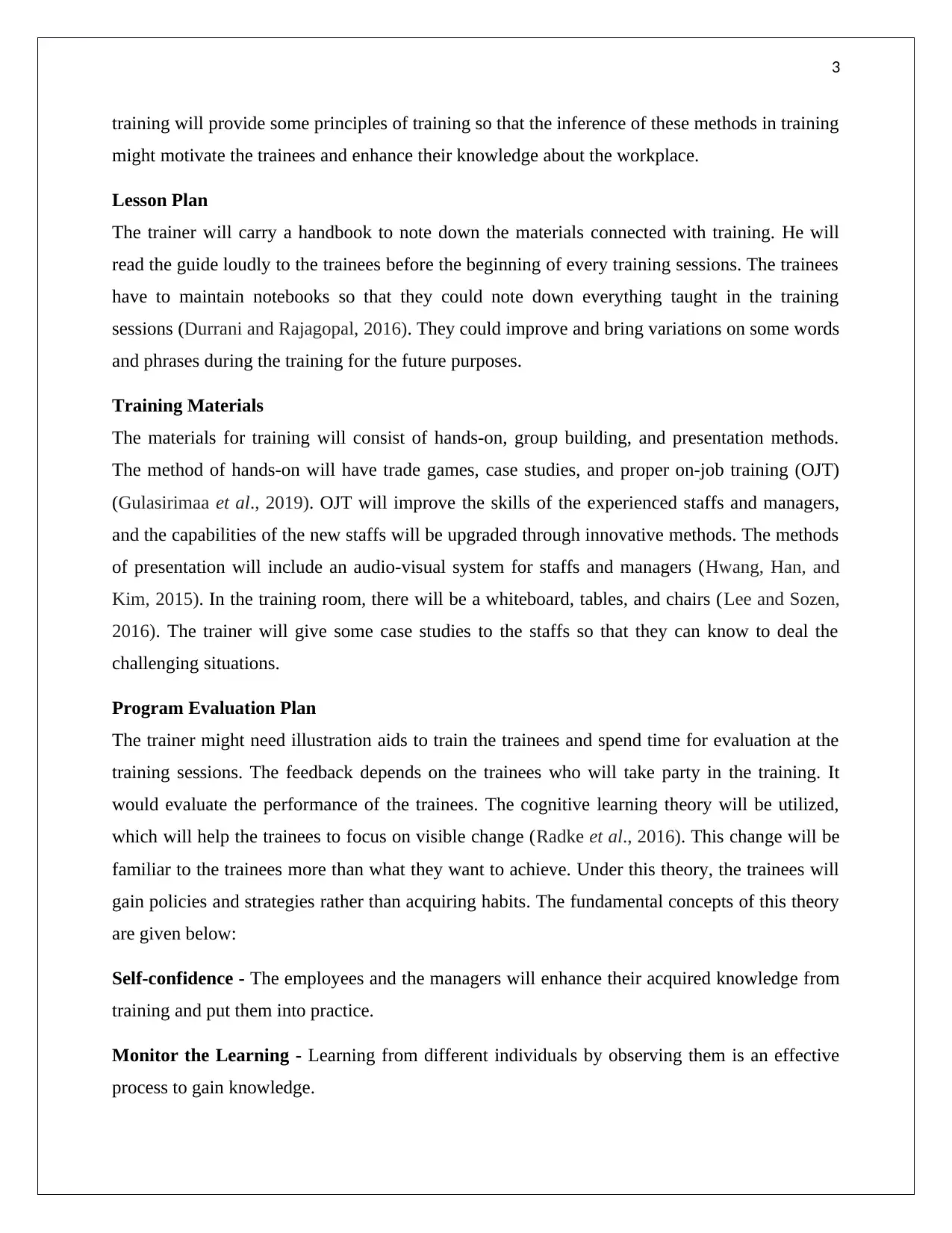
3
training will provide some principles of training so that the inference of these methods in training
might motivate the trainees and enhance their knowledge about the workplace.
Lesson Plan
The trainer will carry a handbook to note down the materials connected with training. He will
read the guide loudly to the trainees before the beginning of every training sessions. The trainees
have to maintain notebooks so that they could note down everything taught in the training
sessions (Durrani and Rajagopal, 2016). They could improve and bring variations on some words
and phrases during the training for the future purposes.
Training Materials
The materials for training will consist of hands-on, group building, and presentation methods.
The method of hands-on will have trade games, case studies, and proper on-job training (OJT)
(Gulasirimaa et al., 2019). OJT will improve the skills of the experienced staffs and managers,
and the capabilities of the new staffs will be upgraded through innovative methods. The methods
of presentation will include an audio-visual system for staffs and managers (Hwang, Han, and
Kim, 2015). In the training room, there will be a whiteboard, tables, and chairs (Lee and Sozen,
2016). The trainer will give some case studies to the staffs so that they can know to deal the
challenging situations.
Program Evaluation Plan
The trainer might need illustration aids to train the trainees and spend time for evaluation at the
training sessions. The feedback depends on the trainees who will take party in the training. It
would evaluate the performance of the trainees. The cognitive learning theory will be utilized,
which will help the trainees to focus on visible change (Radke et al., 2016). This change will be
familiar to the trainees more than what they want to achieve. Under this theory, the trainees will
gain policies and strategies rather than acquiring habits. The fundamental concepts of this theory
are given below:
Self-confidence - The employees and the managers will enhance their acquired knowledge from
training and put them into practice.
Monitor the Learning - Learning from different individuals by observing them is an effective
process to gain knowledge.
training will provide some principles of training so that the inference of these methods in training
might motivate the trainees and enhance their knowledge about the workplace.
Lesson Plan
The trainer will carry a handbook to note down the materials connected with training. He will
read the guide loudly to the trainees before the beginning of every training sessions. The trainees
have to maintain notebooks so that they could note down everything taught in the training
sessions (Durrani and Rajagopal, 2016). They could improve and bring variations on some words
and phrases during the training for the future purposes.
Training Materials
The materials for training will consist of hands-on, group building, and presentation methods.
The method of hands-on will have trade games, case studies, and proper on-job training (OJT)
(Gulasirimaa et al., 2019). OJT will improve the skills of the experienced staffs and managers,
and the capabilities of the new staffs will be upgraded through innovative methods. The methods
of presentation will include an audio-visual system for staffs and managers (Hwang, Han, and
Kim, 2015). In the training room, there will be a whiteboard, tables, and chairs (Lee and Sozen,
2016). The trainer will give some case studies to the staffs so that they can know to deal the
challenging situations.
Program Evaluation Plan
The trainer might need illustration aids to train the trainees and spend time for evaluation at the
training sessions. The feedback depends on the trainees who will take party in the training. It
would evaluate the performance of the trainees. The cognitive learning theory will be utilized,
which will help the trainees to focus on visible change (Radke et al., 2016). This change will be
familiar to the trainees more than what they want to achieve. Under this theory, the trainees will
gain policies and strategies rather than acquiring habits. The fundamental concepts of this theory
are given below:
Self-confidence - The employees and the managers will enhance their acquired knowledge from
training and put them into practice.
Monitor the Learning - Learning from different individuals by observing them is an effective
process to gain knowledge.
Paraphrase This Document
Need a fresh take? Get an instant paraphrase of this document with our AI Paraphraser
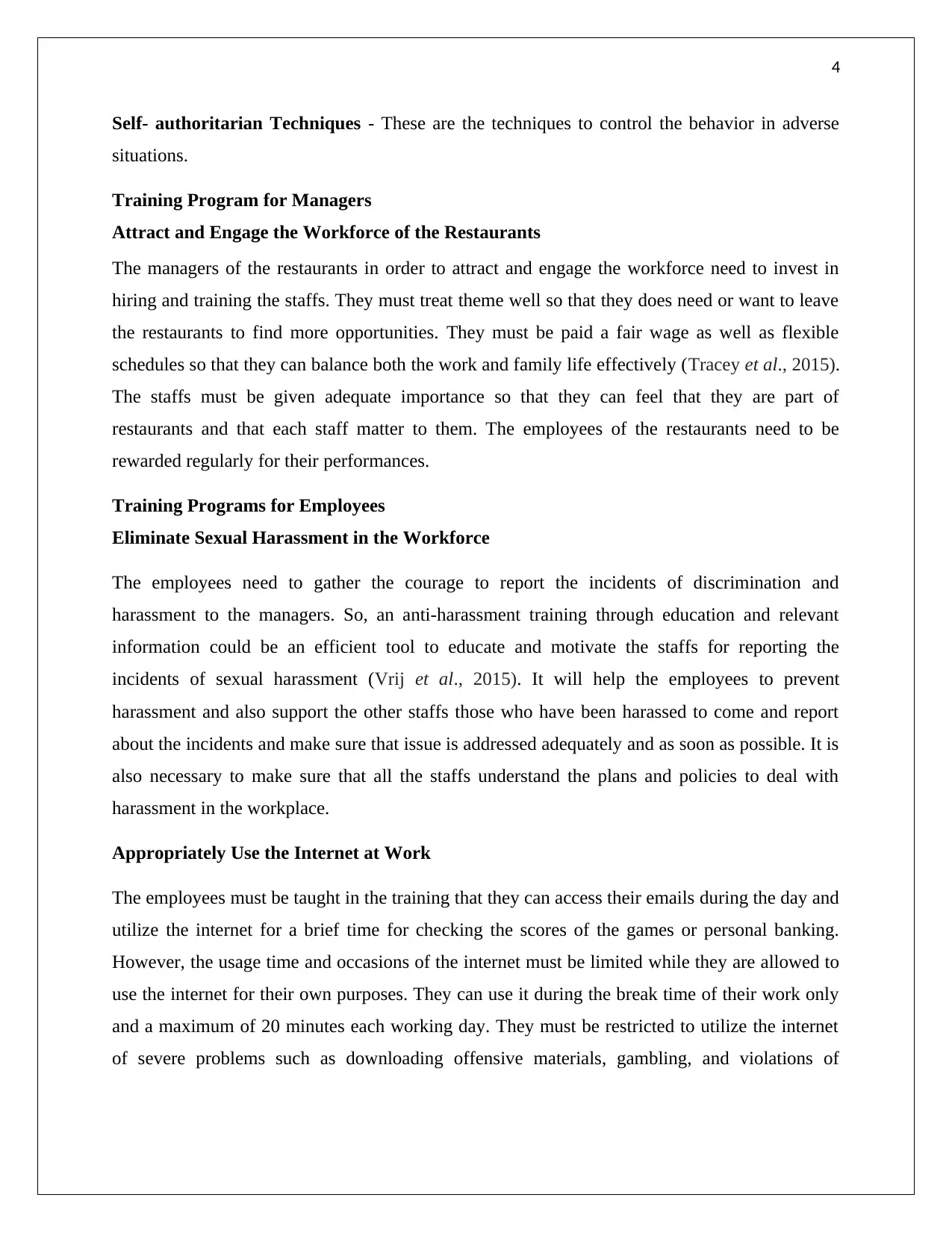
4
Self- authoritarian Techniques - These are the techniques to control the behavior in adverse
situations.
Training Program for Managers
Attract and Engage the Workforce of the Restaurants
The managers of the restaurants in order to attract and engage the workforce need to invest in
hiring and training the staffs. They must treat theme well so that they does need or want to leave
the restaurants to find more opportunities. They must be paid a fair wage as well as flexible
schedules so that they can balance both the work and family life effectively (Tracey et al., 2015).
The staffs must be given adequate importance so that they can feel that they are part of
restaurants and that each staff matter to them. The employees of the restaurants need to be
rewarded regularly for their performances.
Training Programs for Employees
Eliminate Sexual Harassment in the Workforce
The employees need to gather the courage to report the incidents of discrimination and
harassment to the managers. So, an anti-harassment training through education and relevant
information could be an efficient tool to educate and motivate the staffs for reporting the
incidents of sexual harassment (Vrij et al., 2015). It will help the employees to prevent
harassment and also support the other staffs those who have been harassed to come and report
about the incidents and make sure that issue is addressed adequately and as soon as possible. It is
also necessary to make sure that all the staffs understand the plans and policies to deal with
harassment in the workplace.
Appropriately Use the Internet at Work
The employees must be taught in the training that they can access their emails during the day and
utilize the internet for a brief time for checking the scores of the games or personal banking.
However, the usage time and occasions of the internet must be limited while they are allowed to
use the internet for their own purposes. They can use it during the break time of their work only
and a maximum of 20 minutes each working day. They must be restricted to utilize the internet
of severe problems such as downloading offensive materials, gambling, and violations of
Self- authoritarian Techniques - These are the techniques to control the behavior in adverse
situations.
Training Program for Managers
Attract and Engage the Workforce of the Restaurants
The managers of the restaurants in order to attract and engage the workforce need to invest in
hiring and training the staffs. They must treat theme well so that they does need or want to leave
the restaurants to find more opportunities. They must be paid a fair wage as well as flexible
schedules so that they can balance both the work and family life effectively (Tracey et al., 2015).
The staffs must be given adequate importance so that they can feel that they are part of
restaurants and that each staff matter to them. The employees of the restaurants need to be
rewarded regularly for their performances.
Training Programs for Employees
Eliminate Sexual Harassment in the Workforce
The employees need to gather the courage to report the incidents of discrimination and
harassment to the managers. So, an anti-harassment training through education and relevant
information could be an efficient tool to educate and motivate the staffs for reporting the
incidents of sexual harassment (Vrij et al., 2015). It will help the employees to prevent
harassment and also support the other staffs those who have been harassed to come and report
about the incidents and make sure that issue is addressed adequately and as soon as possible. It is
also necessary to make sure that all the staffs understand the plans and policies to deal with
harassment in the workplace.
Appropriately Use the Internet at Work
The employees must be taught in the training that they can access their emails during the day and
utilize the internet for a brief time for checking the scores of the games or personal banking.
However, the usage time and occasions of the internet must be limited while they are allowed to
use the internet for their own purposes. They can use it during the break time of their work only
and a maximum of 20 minutes each working day. They must be restricted to utilize the internet
of severe problems such as downloading offensive materials, gambling, and violations of

5
security and antitrust, infringement of copyright, losses of restaurants’ secrets and other issues
which can take place from misusing internet at the restaurants (Webb and Morancie, 2015).
Manage Stress of the Workplace in the Restaurants
The staffs of the restaurants must be trained to make their work enjoyable and take the
responsibility by themselves to make it an ethical workplace. They can also be motivated to
make suggestions to the managers or the supervisors for constructive and positive changes in the
restaurants to make it a stress-free place to work. They have to be friendly and take an interest in
their colleagues so that their co-workers also behave in a friendly way towards them. With the
permission of the CEO, they can arrange for some social activities after the duty or on the off-
duty day for building a friendship with other employees and managers.
Create an Inclusive Workplace for the Staffs with Disabilities
The employees must be given disability sensitivity training where they must be trained to treat
well and convey inclusive attitudes towards the staffs with disabilities (Vrij et al., 2016). They
are also the same as them except that they have some disabilities. Accommodations must be
arranged for the staffs with disabilities so that they can get full potentials in the job and have
fulfilling job experiences. These accommodations can be some equipment, technologies, or
adaptions, which will allow them to perform their duties. These accommodations might include
wheelchair ramps, ergonomic chairs, and improved lightings. A staff resource team must create
those who will be dedicated to support and advocate these staffs.
Make Safety the First Priority for the Restaurant
All the staffs of the restaurants must be provided safety training and arrange for safety sessions
every week to examine the essential safety processes for their works. They must be trained about
the importance of these processes along with the safety protocols. They must be communicated
about the guidelines of safety protocols of the restaurants and encouraged to take ownerships of
safety for their own as well as their colleagues. They must also be motivated for sharing any
issues of security with the managers of the restaurants. A safe work atmosphere needs to be
considered in the restaurants.
security and antitrust, infringement of copyright, losses of restaurants’ secrets and other issues
which can take place from misusing internet at the restaurants (Webb and Morancie, 2015).
Manage Stress of the Workplace in the Restaurants
The staffs of the restaurants must be trained to make their work enjoyable and take the
responsibility by themselves to make it an ethical workplace. They can also be motivated to
make suggestions to the managers or the supervisors for constructive and positive changes in the
restaurants to make it a stress-free place to work. They have to be friendly and take an interest in
their colleagues so that their co-workers also behave in a friendly way towards them. With the
permission of the CEO, they can arrange for some social activities after the duty or on the off-
duty day for building a friendship with other employees and managers.
Create an Inclusive Workplace for the Staffs with Disabilities
The employees must be given disability sensitivity training where they must be trained to treat
well and convey inclusive attitudes towards the staffs with disabilities (Vrij et al., 2016). They
are also the same as them except that they have some disabilities. Accommodations must be
arranged for the staffs with disabilities so that they can get full potentials in the job and have
fulfilling job experiences. These accommodations can be some equipment, technologies, or
adaptions, which will allow them to perform their duties. These accommodations might include
wheelchair ramps, ergonomic chairs, and improved lightings. A staff resource team must create
those who will be dedicated to support and advocate these staffs.
Make Safety the First Priority for the Restaurant
All the staffs of the restaurants must be provided safety training and arrange for safety sessions
every week to examine the essential safety processes for their works. They must be trained about
the importance of these processes along with the safety protocols. They must be communicated
about the guidelines of safety protocols of the restaurants and encouraged to take ownerships of
safety for their own as well as their colleagues. They must also be motivated for sharing any
issues of security with the managers of the restaurants. A safe work atmosphere needs to be
considered in the restaurants.
⊘ This is a preview!⊘
Do you want full access?
Subscribe today to unlock all pages.

Trusted by 1+ million students worldwide
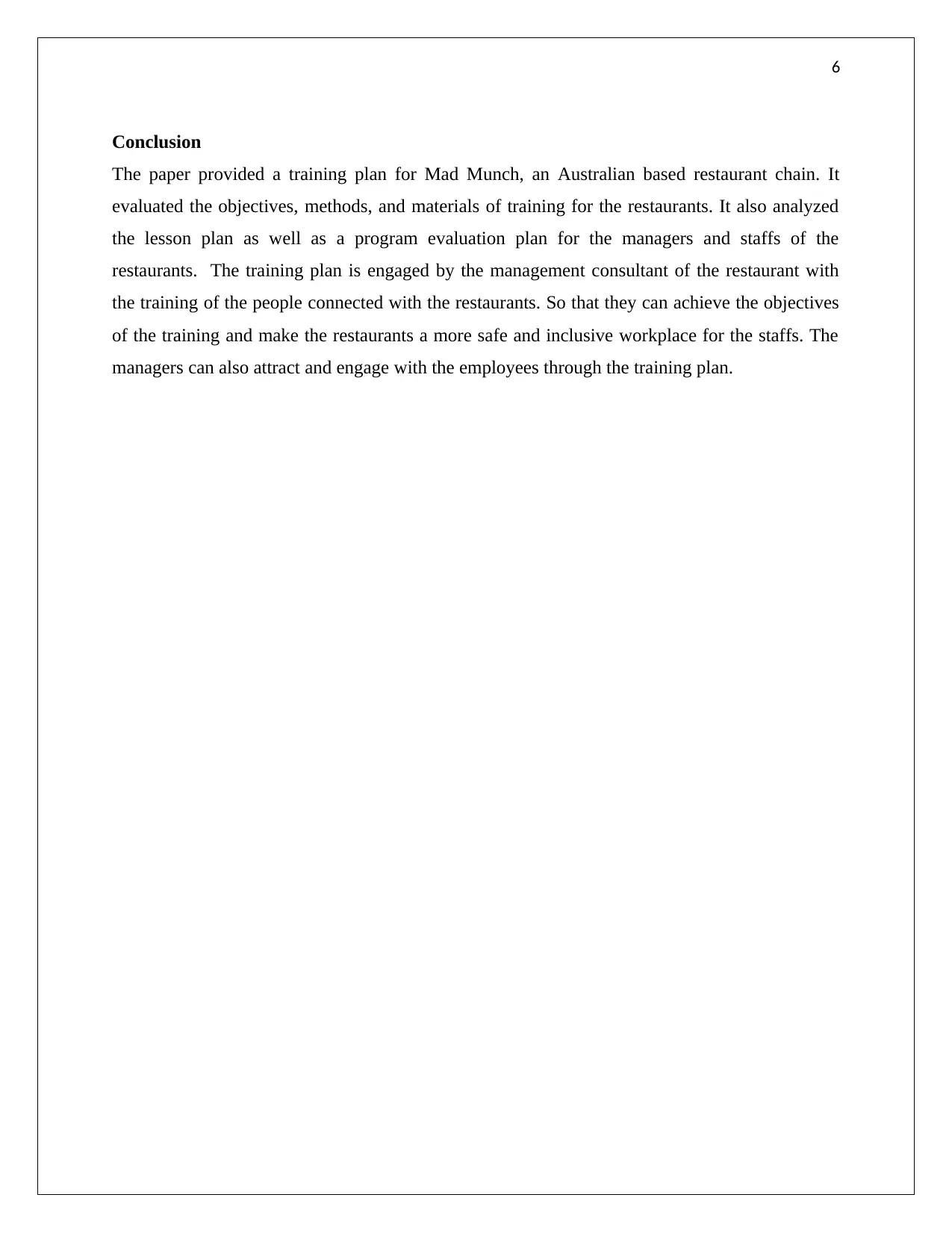
6
Conclusion
The paper provided a training plan for Mad Munch, an Australian based restaurant chain. It
evaluated the objectives, methods, and materials of training for the restaurants. It also analyzed
the lesson plan as well as a program evaluation plan for the managers and staffs of the
restaurants. The training plan is engaged by the management consultant of the restaurant with
the training of the people connected with the restaurants. So that they can achieve the objectives
of the training and make the restaurants a more safe and inclusive workplace for the staffs. The
managers can also attract and engage with the employees through the training plan.
Conclusion
The paper provided a training plan for Mad Munch, an Australian based restaurant chain. It
evaluated the objectives, methods, and materials of training for the restaurants. It also analyzed
the lesson plan as well as a program evaluation plan for the managers and staffs of the
restaurants. The training plan is engaged by the management consultant of the restaurant with
the training of the people connected with the restaurants. So that they can achieve the objectives
of the training and make the restaurants a more safe and inclusive workplace for the staffs. The
managers can also attract and engage with the employees through the training plan.
Paraphrase This Document
Need a fresh take? Get an instant paraphrase of this document with our AI Paraphraser
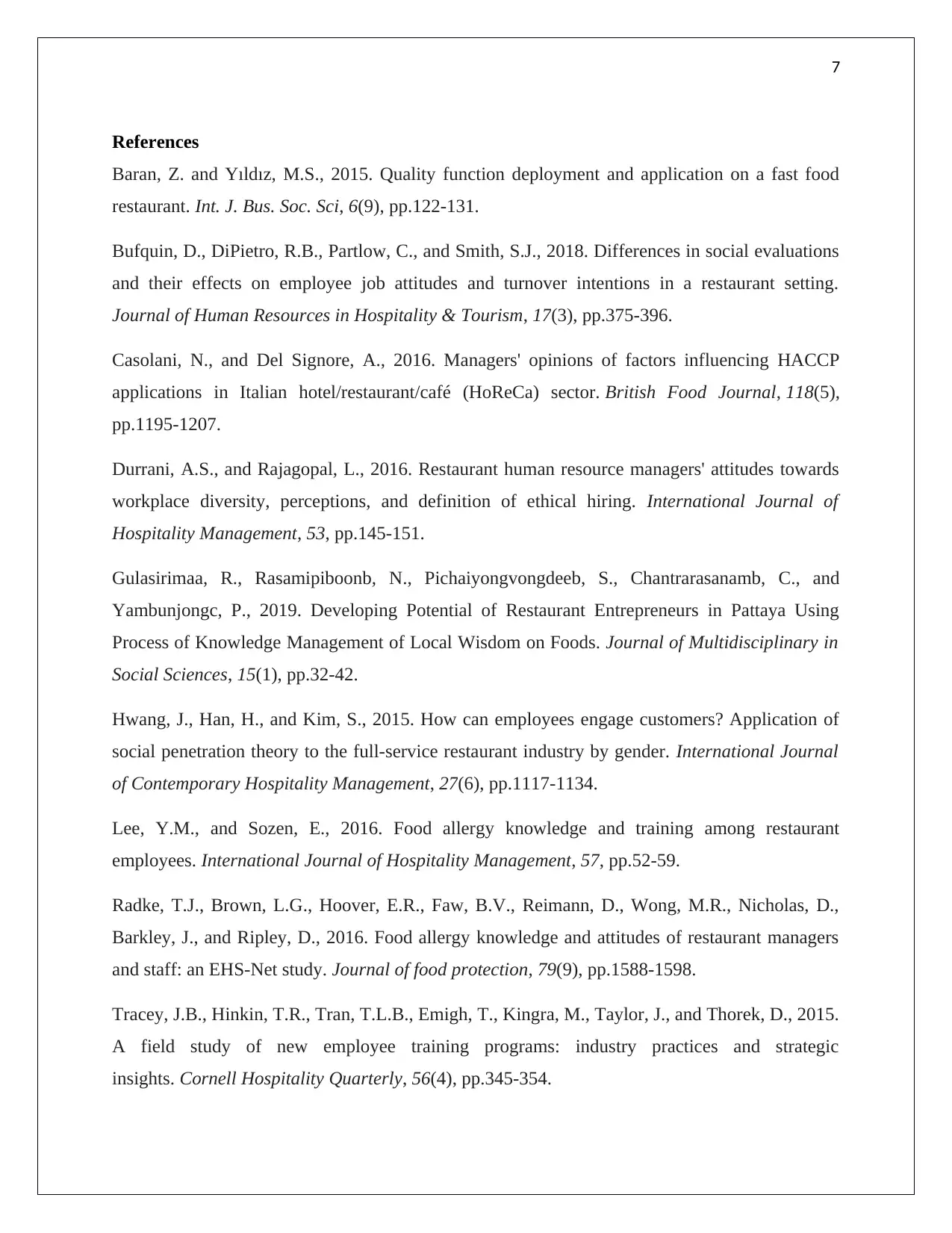
7
References
Baran, Z. and Yıldız, M.S., 2015. Quality function deployment and application on a fast food
restaurant. Int. J. Bus. Soc. Sci, 6(9), pp.122-131.
Bufquin, D., DiPietro, R.B., Partlow, C., and Smith, S.J., 2018. Differences in social evaluations
and their effects on employee job attitudes and turnover intentions in a restaurant setting.
Journal of Human Resources in Hospitality & Tourism, 17(3), pp.375-396.
Casolani, N., and Del Signore, A., 2016. Managers' opinions of factors influencing HACCP
applications in Italian hotel/restaurant/café (HoReCa) sector. British Food Journal, 118(5),
pp.1195-1207.
Durrani, A.S., and Rajagopal, L., 2016. Restaurant human resource managers' attitudes towards
workplace diversity, perceptions, and definition of ethical hiring. International Journal of
Hospitality Management, 53, pp.145-151.
Gulasirimaa, R., Rasamipiboonb, N., Pichaiyongvongdeeb, S., Chantrarasanamb, C., and
Yambunjongc, P., 2019. Developing Potential of Restaurant Entrepreneurs in Pattaya Using
Process of Knowledge Management of Local Wisdom on Foods. Journal of Multidisciplinary in
Social Sciences, 15(1), pp.32-42.
Hwang, J., Han, H., and Kim, S., 2015. How can employees engage customers? Application of
social penetration theory to the full-service restaurant industry by gender. International Journal
of Contemporary Hospitality Management, 27(6), pp.1117-1134.
Lee, Y.M., and Sozen, E., 2016. Food allergy knowledge and training among restaurant
employees. International Journal of Hospitality Management, 57, pp.52-59.
Radke, T.J., Brown, L.G., Hoover, E.R., Faw, B.V., Reimann, D., Wong, M.R., Nicholas, D.,
Barkley, J., and Ripley, D., 2016. Food allergy knowledge and attitudes of restaurant managers
and staff: an EHS-Net study. Journal of food protection, 79(9), pp.1588-1598.
Tracey, J.B., Hinkin, T.R., Tran, T.L.B., Emigh, T., Kingra, M., Taylor, J., and Thorek, D., 2015.
A field study of new employee training programs: industry practices and strategic
insights. Cornell Hospitality Quarterly, 56(4), pp.345-354.
References
Baran, Z. and Yıldız, M.S., 2015. Quality function deployment and application on a fast food
restaurant. Int. J. Bus. Soc. Sci, 6(9), pp.122-131.
Bufquin, D., DiPietro, R.B., Partlow, C., and Smith, S.J., 2018. Differences in social evaluations
and their effects on employee job attitudes and turnover intentions in a restaurant setting.
Journal of Human Resources in Hospitality & Tourism, 17(3), pp.375-396.
Casolani, N., and Del Signore, A., 2016. Managers' opinions of factors influencing HACCP
applications in Italian hotel/restaurant/café (HoReCa) sector. British Food Journal, 118(5),
pp.1195-1207.
Durrani, A.S., and Rajagopal, L., 2016. Restaurant human resource managers' attitudes towards
workplace diversity, perceptions, and definition of ethical hiring. International Journal of
Hospitality Management, 53, pp.145-151.
Gulasirimaa, R., Rasamipiboonb, N., Pichaiyongvongdeeb, S., Chantrarasanamb, C., and
Yambunjongc, P., 2019. Developing Potential of Restaurant Entrepreneurs in Pattaya Using
Process of Knowledge Management of Local Wisdom on Foods. Journal of Multidisciplinary in
Social Sciences, 15(1), pp.32-42.
Hwang, J., Han, H., and Kim, S., 2015. How can employees engage customers? Application of
social penetration theory to the full-service restaurant industry by gender. International Journal
of Contemporary Hospitality Management, 27(6), pp.1117-1134.
Lee, Y.M., and Sozen, E., 2016. Food allergy knowledge and training among restaurant
employees. International Journal of Hospitality Management, 57, pp.52-59.
Radke, T.J., Brown, L.G., Hoover, E.R., Faw, B.V., Reimann, D., Wong, M.R., Nicholas, D.,
Barkley, J., and Ripley, D., 2016. Food allergy knowledge and attitudes of restaurant managers
and staff: an EHS-Net study. Journal of food protection, 79(9), pp.1588-1598.
Tracey, J.B., Hinkin, T.R., Tran, T.L.B., Emigh, T., Kingra, M., Taylor, J., and Thorek, D., 2015.
A field study of new employee training programs: industry practices and strategic
insights. Cornell Hospitality Quarterly, 56(4), pp.345-354.
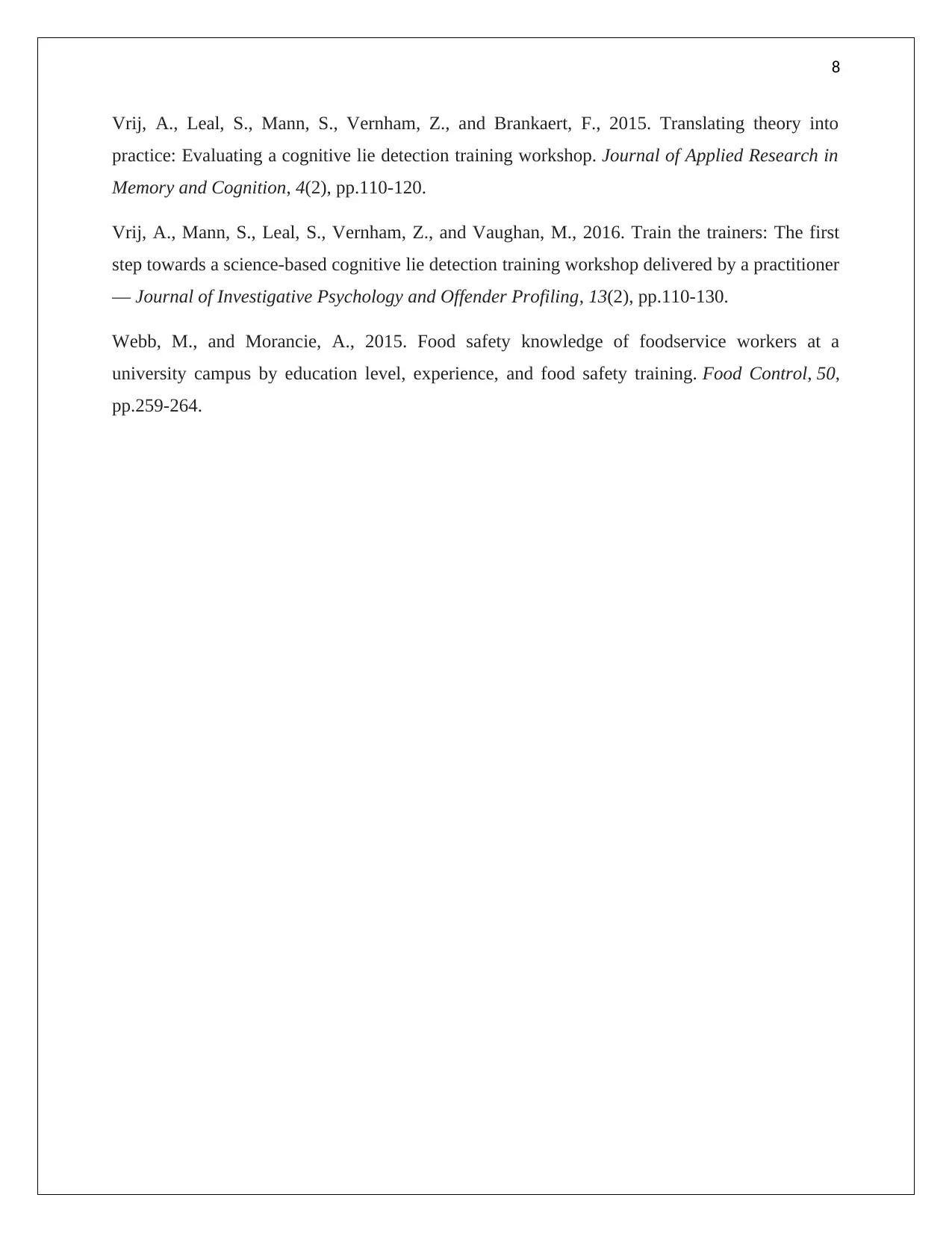
8
Vrij, A., Leal, S., Mann, S., Vernham, Z., and Brankaert, F., 2015. Translating theory into
practice: Evaluating a cognitive lie detection training workshop. Journal of Applied Research in
Memory and Cognition, 4(2), pp.110-120.
Vrij, A., Mann, S., Leal, S., Vernham, Z., and Vaughan, M., 2016. Train the trainers: The first
step towards a science‐based cognitive lie detection training workshop delivered by a practitioner
— Journal of Investigative Psychology and Offender Profiling, 13(2), pp.110-130.
Webb, M., and Morancie, A., 2015. Food safety knowledge of foodservice workers at a
university campus by education level, experience, and food safety training. Food Control, 50,
pp.259-264.
Vrij, A., Leal, S., Mann, S., Vernham, Z., and Brankaert, F., 2015. Translating theory into
practice: Evaluating a cognitive lie detection training workshop. Journal of Applied Research in
Memory and Cognition, 4(2), pp.110-120.
Vrij, A., Mann, S., Leal, S., Vernham, Z., and Vaughan, M., 2016. Train the trainers: The first
step towards a science‐based cognitive lie detection training workshop delivered by a practitioner
— Journal of Investigative Psychology and Offender Profiling, 13(2), pp.110-130.
Webb, M., and Morancie, A., 2015. Food safety knowledge of foodservice workers at a
university campus by education level, experience, and food safety training. Food Control, 50,
pp.259-264.
⊘ This is a preview!⊘
Do you want full access?
Subscribe today to unlock all pages.

Trusted by 1+ million students worldwide
1 out of 9
Related Documents
Your All-in-One AI-Powered Toolkit for Academic Success.
+13062052269
info@desklib.com
Available 24*7 on WhatsApp / Email
![[object Object]](/_next/static/media/star-bottom.7253800d.svg)
Unlock your academic potential
Copyright © 2020–2025 A2Z Services. All Rights Reserved. Developed and managed by ZUCOL.





